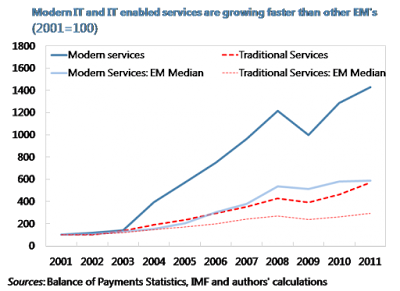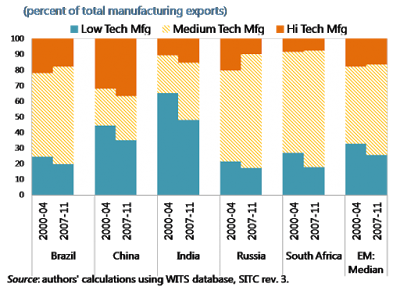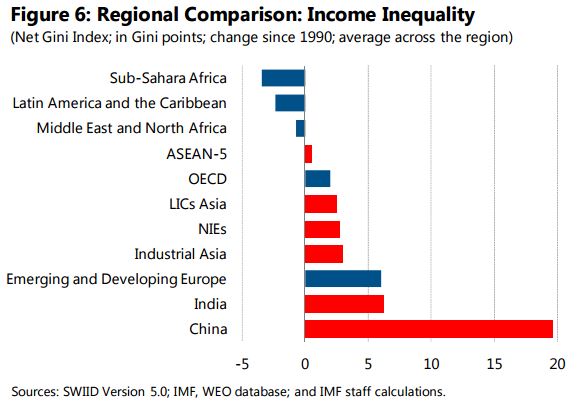Thursday, March 17, 2016
Make in India: Which exports can drive the next wave of growth?
Structural transformation depends not only on how much countries export but also on what they export and with whom they trade. In my new IMF working paper with Rahul Anand and Kalpana Kochhar, we break new grounds in analyzing India’s exports by the technological content, quality, sophistication, and complexity of India’s export basket. The paper can be found here. Here are few key pieces of evidence from our paper:
Technological content of India’s exports
The evolution of Indian exports has not followed a “textbook” pattern. The pattern of evolution points to a dichotomy in the Indian economy – a well integrated, technologically advanced services sector and a relatively lagging manufacturing sector. The share of service exports in total exports has grown to over 32 percent in 2013 from 28 percent in 2000. On the other hand, the share of manufacturing exports in total export has declined to 67 percent from nearly 80 percent during 1990-2013.
The growth in service exports has been more rapid, resulting in the share of services exports in total exports to increase rapidly over the last decade. This can be explained by technological changes. Many services do not require face-to-face interaction, and can be stored and traded digitally. These services are called modern services. Modern services are the fastest growing sector of the global economy. This is particularly evident in India, where modern services exports account for nearly 70 percent of the total commercial services exports (compared to around 35 percent in EMs) (see Figure 1).
Within manufacturing exports, there is a clear shift away from traditional exports, such as textiles, gems, and leather products, towards high-tech and medium-tech manufacturing products. The relative share of high-tech manufacturing exports has been increasing (however lower when compared to China or other EMs); Resource based production and low-tech manufacturing dominate the goods export basket (Figure 2).
Manufactured machinery accounts for almost 10 percent, while textile and garments account for more than 15 percent of India’s merchandise exports. In resource-based products – refined petroleum oil, cotton, jewelry of precious metals, and rice – constitute majority of export. In low-tech manufacturing exports – jewelry, textile and apparel based exports constitute the majority of India’s exports. In medium-tech manufacturing – the automotive industry dominates the basket, with machinery, various motor vehicle intermediary inputs for cars, bikes, construction, mining equipment and cosmetics making up the major portion. In the high technology export basket – veterinary and pharmaceutical products, television, telecommunication transistors, aircraft components, X-ray equipment and electronic R&D in electro-medical, power and automotive industry are key elements of the export basket. The main contribution of our work is to comprehensively document Indian exports, which has not been done over the past decade.
Continue reading here.
From Saurabh Mishra:
Structural transformation depends not only on how much countries export but also on what they export and with whom they trade. In my new IMF working paper with Rahul Anand and Kalpana Kochhar, we break new grounds in analyzing India’s exports by the technological content, quality, sophistication, and complexity of India’s export basket. The paper can be found here. Here are few key pieces of evidence from our paper:
Technological content of India’s exports
The evolution of Indian exports has not followed a “textbook” pattern.
Posted by at 8:45 PM
Labels: Uncategorized
Wednesday, March 16, 2016
House Prices in Indonesia
“Property prices have been subdued, in tandem with slowing economic growth and weak business sentiment”, notes IMF’s report on Indonesia.
Posted by at 9:00 AM
Labels: Global Housing Watch
Friday, March 11, 2016
House Prices in Montenegro
“Property prices have continued to fall from their crisis peaks, in part because Russian buying has fallen”, notes the IMF’s report on Montenegro.
Posted by at 10:00 AM
Labels: Global Housing Watch
Wednesday, March 9, 2016
House Prices in Belgium
“After a long period of rapid growth, house prices have stabilized since 2013. A sharp reversal could have a significant impact on consumption, even if banks’ exposures could be managed (…). However, staff analysis does not suggest a major overvaluation, as past price trends were broadly in line with borrowing cost, demographic and income developments”, according to the IMF’s new report on Belgium.
Posted by at 10:00 AM
Labels: Global Housing Watch
Friday, March 4, 2016
Sharing the Growth Dividend: Analysis of Inequality in Asia
A new IMF “paper focuses on income inequality in Asia, its drivers and policies to combat it. It finds that income inequality has risen in most of Asia, in contrast to many regions. While in the past, rapid growth in Asia has come with equitable distribution of the gains, more recently fast-growing Asian economies have been unable to replicate the “growth with equity” miracle. There is a growing consensus that high levels of inequality can hamper the pace and sustainability of growth. Read the full article…
Posted by at 10:24 PM
Labels: Inclusive Growth
Subscribe to: Posts










